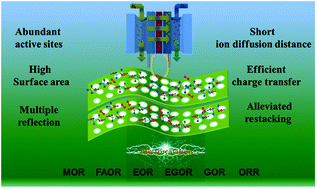Recent advances in fuel cell reaction electrocatalysis based on porous noble metal nanocatalysts
Abstract
As the center of fuel cells, electrocatalysts play a crucial role in determining the conversion efficiency from chemical energy to electrical energy. Therefore, the development of advanced electrocatalysts with both high activity and stability is significant but challenging. Active site, mass transport, and charge transfer are three central factors influencing the catalytic performance of electrocatalysts. Endowed with rich available surface active sites, facilitated electron transfer and mass diffusion channels, and highly active components, porous noble metal nanomaterials are widely considered as promising electrocatalysts toward fuel cell-related reactions. The past decade has witnessed great achievements in the design and fabrication of advanced porous noble metal nanocatalysts in the field of electrocatalytic fuel oxidation reaction (FOR) and oxygen reduction reaction (ORR). Herein, the recent research advances regarding porous noble metal nanocatalysts for fuel cell-related reactions are reviewed. In the discussions, the inherent structural features of porous noble metal nanostructures for electrocatalytic reactions, advanced synthetic strategies for the fabrication of porous noble metal nanostructures, and the structure–performance relationships are also provided.

- This article is part of the themed collection: 2022 Frontier and Perspective articles


 Please wait while we load your content...
Please wait while we load your content...